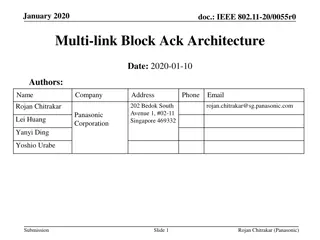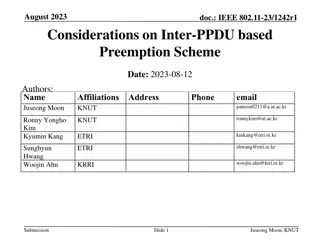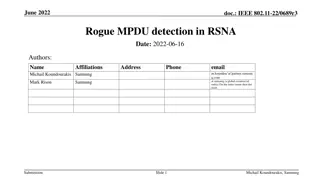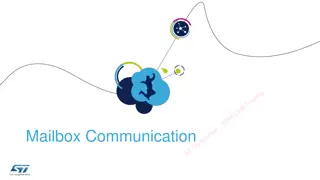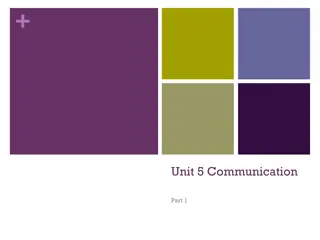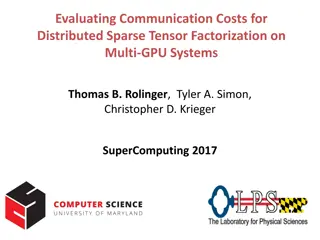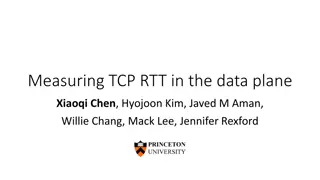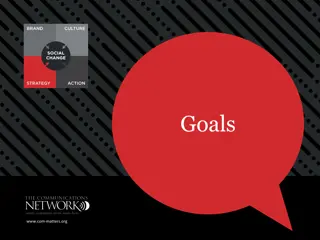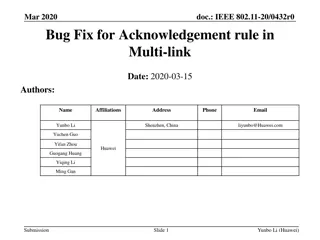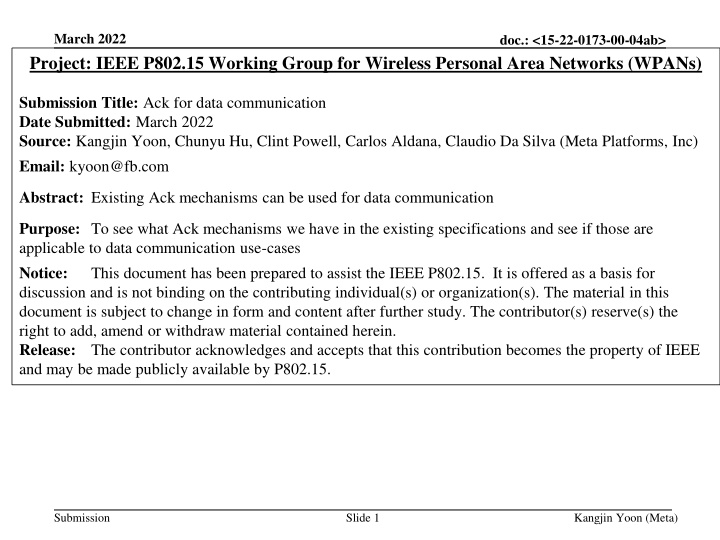
Ack Mechanisms in Existing Specifications for Data Communication
Explore existing Ack mechanisms in IEEE specifications like 802.15.4-2020 and 802.15.4z-2020 for data communication use-cases. Learn how Explicit Ack can enhance reliability in wireless personal area networks (WPANs).
Download Presentation

Please find below an Image/Link to download the presentation.
The content on the website is provided AS IS for your information and personal use only. It may not be sold, licensed, or shared on other websites without obtaining consent from the author. If you encounter any issues during the download, it is possible that the publisher has removed the file from their server.
You are allowed to download the files provided on this website for personal or commercial use, subject to the condition that they are used lawfully. All files are the property of their respective owners.
The content on the website is provided AS IS for your information and personal use only. It may not be sold, licensed, or shared on other websites without obtaining consent from the author.
E N D
Presentation Transcript
March 2022 Project: IEEE P802.15 Working Group for Wireless Personal Area Networks (WPANs) doc.: <15-22-0173-00-04ab> Submission Title: Ack for data communication Date Submitted: March 2022 Source: Kangjin Yoon, Chunyu Hu, Clint Powell, Carlos Aldana, Claudio Da Silva (Meta Platforms, Inc) Email: kyoon@fb.com Abstract: Existing Ack mechanisms can be used for data communication Purpose: To see what Ack mechanisms we have in the existing specifications and see if those are applicable to data communication use-cases Notice: This document has been prepared to assist the IEEE P802.15. It is offered as a basis for discussion and is not binding on the contributing individual(s) or organization(s). The material in this document is subject to change in form and content after further study. The contributor(s) reserve(s) the right to add, amend or withdraw material contained herein. Release: The contributor acknowledges and accepts that this contribution becomes the property of IEEE and may be made publicly available by P802.15. Submission Slide 1 Kangjin Yoon (Meta)
March 2022 doc.: <15-22-0173-00-04ab> PAR Objective Safeguards so that the high throughput data use cases will not cause significant disruption to low duty-cycle ranging use cases Interference mitigation techniques to support higher density and higher traffic use cases Other coexistence improvement Backward compatibility with enhanced ranging capable devices (ERDEVs) Improved link budget and/or reduced air-time Proposed Solution (how addressed) RMMRC IE can reduce air-time by reducing the number of Ack frames Additional channels and operating frequencies Improvements to accuracy / precision / reliability and interoperability for high-integrity ranging Reduced complexity and power consumption Hybrid operation with narrowband signaling to assist UWB Enhanced native discovery and connection setup mechanisms Sensing capabilities to support presence detection and environment mapping Low-power low-latency streaming RMMRC IE can reduce power by reducing the number of Ack frames Ack mechanism for higher data-rate use-case Higher data-rate streaming allowing at least 50 Mbit/s of throughput Support for peer-to-peer, peer-to-multi-peer, and station-to- infrastructure protocols Infrastructure synchronization mechanisms Peer-to-peer and peer-to-multi-peer Ack mechanism Submission Slide 2 Kangjin Yoon (Meta)
March 2022 doc.: <15-22-0173-00-04ab> Introduction Most ranging applications are not using explicit Ack 802.15.4-2020 and 802.15.4z-2020 both define explicit Ack mechanisms Explicit Ack is an important building block for reliability, which is a common requirement for data communication Explicit Ack as an optional feature In this presentation, we will revisit existing Ack mechanisms and see how these can be used for data communication Submission Slide 3 Kangjin Yoon (Meta)
March 2022 doc.: <15-22-0173-00-04ab> Enhanced-Ack (Enh-Ack) Enh-Ack can be transmitted right after AIFS[1]from the end of reception Requested by Ack Request (AR) field in MHR Frame Control field indicates the presence of each field (i.e., Sequence Number, destination address, source address, IE, etc.) [1] AIFS: Ack Interframe Spacing [2] Enh-Ack can be used for 15.4-2003/2006 version frame only Submission Slide 4 Kangjin Yoon (Meta)
March 2022 doc.: <15-22-0173-00-04ab> Example of Enh-Ack Sequence Number and Destination Address Octets: 2 1 2 2 Destination Address Frame Control Sequence Number FCS MHR MFR Submission Slide 5 Kangjin Yoon (Meta)
March 2022 doc.: <15-22-0173-00-04ab> Data-Ack Interframe Spacing Ack frame shall be transmitted X us after receiving the data frame. What should be the choice of X us for 4ab? Option-1: Adopt the existing Ack Interframe Spacing (AIFS) value defined in 15.4-2020 The value of AIFS is equal to ?????????????, which is defined as 12 preamble symbols (see below table) Option-2: Consider possible new coding scheme (e.g., LDPC) and/or maximum PSDU size that may be introduced in 4ab, etc. may require to define new IFS value for Ack Symbol duration (ns) Ranging Slot AIFS (us) HPRF 729.17 8.75 ACK ACK 993.6 11.92 Control Data BPRF 1017.6 12.21 AIFS AIFS Submission Slide 6 Kangjin Yoon (Meta)
March 2022 doc.: <15-22-0173-00-04ab> Ranging Multiple Message Receipt Confirmation IE (RMMRC IE) Introduced in 4z-2020 Ack for multiple messages Multiple Message Receipt Confirmation (MMRC) List field can have multiple MMRC List elements MMRC Bitmap field: Each bit maps to the slots in the ranging round and confirms the receipt of a message in the slot Submission Slide 7 Kangjin Yoon (Meta)
March 2022 doc.: <15-22-0173-00-04ab> Ranging Multiple Message Receipt Confirmation IE (RMMRC IE) Control Message can allocate a slot for RMMRC IE transmission Ranging Slot RMMRC IE Control Data Data Ranging Round Submission Slide 8 Kangjin Yoon (Meta)
March 2022 doc.: <15-22-0173-00-04ab> RMMRC IE: Ack for Broadcast frames Controller may assign multiple slots/frames for broadcasting to multiple devices. Receiver can use RMMRC IE to Ack them Ranging Slot RMMRC IE from Device A RMMRC IE from Device B Broadcast Data Broadcast Data Control Ranging Round Submission Slide 9 Kangjin Yoon (Meta)
March 2022 doc.: <15-22-0173-00-04ab> Comparison Between Enh-Ack and RMMRC IE Enh-Ack RMMRC IE Scheduled slot Transmission timing AIFS after receiving the Data frame Ack Frame Immediate confirmation Frame Type Pros Data Frame Ack for multiple data (less overhead), Ack for broadcast data frame(s) Submission Slide 10 Kangjin Yoon (Meta)
March 2022 doc.: <15-22-0173-00-04ab> Summary We can utilize both Enh-Ack and/or RMMRC IE for Ack for data frame(s) wherever applicable Enh-Ack is the fastest way to let the data frame transmitter knows the successful reception RMMRC IE can reduce overhead if used to acknowledge multiple frames and/or broadcast frames Submission Slide 11 Kangjin Yoon (Meta)
March 2022 doc.: <15-22-0173-00-04ab> Appendix Slide 12 Submission Kangjin Yoon (Meta)
March 2022 doc.: <15-22-0173-00-04ab> Immediate-Ack (Imm-Ack) Ack for 15.4-2003/2006 version frame Requested by Ack Request (AR) field in MHR Sequence number only 15.4-2003/2006 version frame cannot have IE ? 4ab frames Not applicable for 4z or Submission Slide 13 Kangjin Yoon (Meta)





